
A garden tub1 offers luxury and relaxation, but many homeowners don’t know its full potential.
A garden tub is a large, deep soaking bathtub designed for comfort and elegance, often found in spacious bathrooms.
Explore the history, design, and modern-day relevance of garden tubs to decide if one is right for you.
What exactly is a garden tub, and why is it called that?
A garden tub is a large, freestanding bathtub specifically designed for deep soaking2, offering a luxurious and spa-like bathing experience. These tubs are known for their extra depth and spacious design, making them ideal for full-body immersion and relaxation.
Why is it called a garden tub?
The name "garden tub" originates from its early use in homes with scenic garden views, where homeowners could unwind while enjoying nature through large windows. Over time, the term has come to describe any oversized soaking tub that prioritizes comfort, regardless of whether it’s near a garden. Historically, garden tubs were installed in sunlit spaces to create a tranquil atmosphere, combining indoor luxury with outdoor serenity.
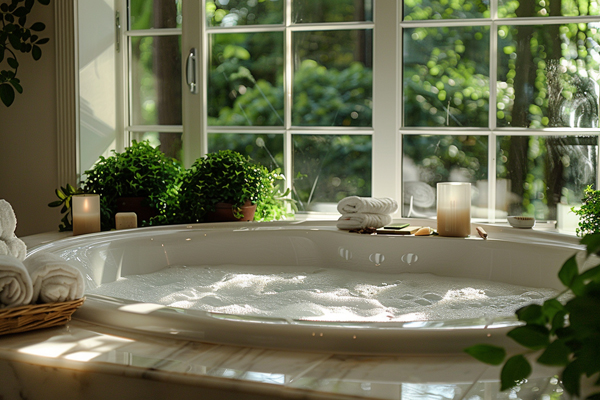
Key Features of a Garden Tub
| Feature | Description |
|---|---|
| Size | Typically 60 inches or more in length and 24 inches deep for full-body soaking |
| Shape | Oval, round, or uniquely designed to enhance aesthetics and comfort |
| Placement | Often freestanding, commonly positioned near large windows or in open bathroom layouts |
| Functionality | Primarily intended for soaking, without integrated shower fixtures, focusing on relaxation |
Why choose a garden tub?
Garden tubs are perfect for those seeking a high-end, spa-like experience at home. Their spacious design caters to users who value comfort over space efficiency, making them popular in master bathrooms and luxury renovations. For homeowners wanting a statement piece that adds elegance and enhances daily self-care routines, a garden tub is an ideal choice.
How does a garden tub compare to other types of bathtubs?
Garden tubs are known for their oversized design, setting them apart from traditional tubs by offering a luxurious, spa-like experience with greater depth and space.
What makes a garden tub different?
Unlike standard bathtubs, garden tubs prioritize comfort and deep soaking over space efficiency, making them ideal for relaxation rather than quick, functional bathing. While standard tubs focus on practicality and fit into compact spaces, garden tubs serve as a statement feature in high-end bathrooms, emphasizing personal comfort, aesthetics, and full-body immersion.

Key Differences
- Depth: Standard bathtubs are typically 14–17 inches deep, limiting soaking capability, while garden tubs reach 24 inches or more, allowing full-body submersion for true relaxation.
- Shape: Standard tubs are usually rectangular and built into an alcove, whereas garden tubs often feature oval, circular, or custom shapes for added comfort and design appeal.
- Placement: Garden tubs are freestanding, often placed in open layouts or near large windows to create a luxury focal point, unlike standard tubs that are enclosed by walls.
- Functionality: Standard tubs are practical for everyday use and combined with showers, while garden tubs are purely designed for extended soaking and self-care rituals.
Comparison Table
| Type of Tub | Depth | Freestanding? | Purpose |
|---|---|---|---|
| Standard Tub | 14–17 inches | No | Basic bathing |
| Garden Tub | 24+ inches | Yes | Deep soaking |
| Roman Tub | 20+ inches | Yes | Elegant relaxation |
Why choose a garden tub over other types?
If your priority is ultimate comfort, luxury design, and a spa-like soaking experience, a garden tub is the best choice. However, they require more bathroom space and higher water usage, making them most suitable for larger bathrooms and homeowners who want a feature piece that turns bathing into a relaxing ritual.
What’s the difference between a garden tub and a hot tub?
A garden tub and a hot tub serve different purposes.
A garden tub is designed for indoor soaking, while a hot tub is meant for outdoor use with heated water circulation.

Hot tubs use jets and heating elements to maintain warm water and provide hydrotherapy3. Garden tubs, on the other hand, rely on a manual fill-and-drain system with no heating function. If you want constant warmth and massage-like water pressure, a hot tub is the better choice.
Key Differences Between a Garden Tub and a Hot Tub
| Feature | Garden Tub | Hot Tub |
|---|---|---|
| Location | Indoors, typically in a bathroom | Outdoors, often on a deck or patio |
| Water Heating | No built-in heating; water cools naturally | Includes jets and heating elements for warmth |
| Functionality | Primarily for deep soaking and relaxation | Hydrotherapy with water jets and bubbles |
| Maintenance | Minimal upkeep; drain after each use | Regular maintenance required to balance water chemistry |
| Installation | Standard bathroom plumbing required | Requires electrical setup and water filtration |
A garden tub offers a tranquil, spa-like soaking experience, perfect for long baths in a peaceful bathroom setting. It doesn’t include water circulation or heating features, meaning the bathwater will cool down over time.
In contrast, a hot tub is built for continuous use with an integrated heating system and powerful jets that provide therapeutic benefits. This makes it ideal for relieving muscle tension and social relaxation in an outdoor setting.
Which One Is Right for You?
Choosing between a garden tub and a hot tub depends on your lifestyle and home setup.
- If you enjoy solitary relaxation indoors, a garden tub is a better fit.
- If you want heated water and hydrotherapy, a hot tub is the way to go.
Ultimately, garden tubs provide a classic, low-maintenance bathing experience, while hot tubs cater to those seeking constant warmth and therapeutic massage effects.
Factors to Consider Before Choosing
When deciding between a garden tub and a hot tub, there are several key aspects to take into account:
| Factor | Garden Tub | Hot Tub |
|---|---|---|
| Installation Cost | Lower; only requires bathroom plumbing | Higher; requires electrical setup and filtration system |
| Space Requirement | Indoor space in a bathroom | Outdoor space on a deck, patio, or backyard |
| Water Usage | Uses fresh water for each bath | Recycles water with filtration system |
| Maintenance | Minimal; drain after each use | Regular water treatment and upkeep needed |
| Heating | No built-in heater | Includes heating system for warm water |
| Primary Purpose | Soaking and relaxation | Hydrotherapy and social bathing |
Lifestyle and Personal Preferences
Your decision should align with your daily habits and home setup:
- Do you prefer a quiet, spa-like bath in private? A garden tub offers deep soaking comfort without ongoing maintenance.
- Do you enjoy entertaining guests and social relaxation? A hot tub is a great outdoor addition for gatherings.
- Are you looking for therapeutic benefits? The jets in a hot tub can help relieve sore muscles and improve circulation.
- Do you want a low-maintenance option? A garden tub requires less upkeep since you fill and drain it per use.
Ultimately, if you seek convenience and minimal effort, a garden tub is ideal. If you want a heated, high-tech relaxation experience, a hot tub is worth considering.
How does a garden tub compare to a Roman tub?
Both tubs offer deep soaking, but their designs differ.
A Roman tub4 is built into the bathroom structure, while a garden tub is freestanding.
Roman tubs often have tiled steps leading into them, adding an element of elegance. Garden tubs, however, maintain an open-air appeal and are easier to install.

Key Differences Between a Garden Tub and a Roman Tub
| Feature | Garden Tub | Roman Tub |
|---|---|---|
| Installation | Freestanding, easy to install | Built into bathroom structure with steps |
| Design | Open-air, often placed near windows | Integrated into the floor or platform |
| Size | Typically large and deep | Equally spacious, often wider |
| Aesthetic | Modern and luxurious | Classic and elegant with tiled finishes |
| Usage | Primarily for deep soaking | Designed for both soaking and easy access |
Which One Suits Your Needs?
When choosing between a garden tub and a Roman tub, consider your design preferences and bathroom layout:
- Do you want flexibility in placement? A garden tub is the better choice, as it doesn’t require built-in construction.
- Are you aiming for a classic, luxurious feel? A Roman tub integrates seamlessly into high-end bathroom designs.
- Do you prefer a deep soaking experience? Both options offer ample depth, but a garden tub provides more freestanding comfort.
While garden tubs offer modern versatility, Roman tubs appeal to those who appreciate elegance and historical charm.
Why are garden tubs so common in mobile homes?
Mobile homes often include garden tubs due to their lightweight design and luxurious feel.
Manufacturers include them to add a high-end touch without increasing structural weight.
Since mobile homes have space limitations, garden tubs provide a spa-like experience5 without requiring extensive bathroom modifications.
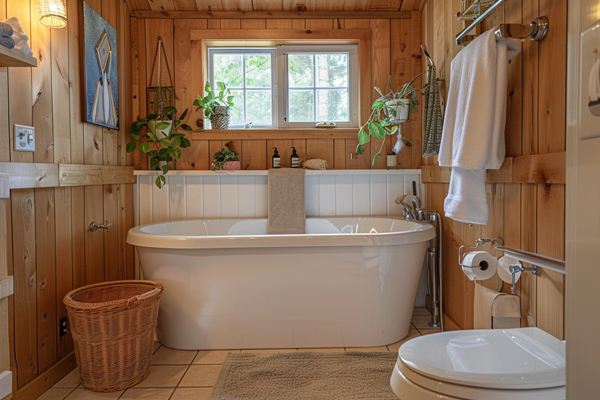
Advantages of Garden Tubs in Mobile Homes
Garden tubs are a popular choice in mobile homes because they offer a balance between luxury and practicality.
| Feature | Benefit in Mobile Homes |
|---|---|
| Lightweight Design | Reduces stress on the mobile home structure |
| Spacious Soaking Area | Provides a deep, relaxing bath experience |
| No Heavy Plumbing Requirements | Easier to install compared to traditional tubs |
| Affordable Luxury | Enhances the home’s value without significant cost |
| Compact Yet Functional | Fits within space limitations while offering comfort |
Why Do Manufacturers Prefer Garden Tubs?
- Aesthetic Appeal – A garden tub enhances the bathroom’s appearance, making it look more high-end.
- Cost-Effective Upgrade – Compared to built-in jacuzzis or large bathtubs, a garden tub is more budget-friendly.
- Ease of Installation – Since garden tubs are freestanding, they require minimal modifications to the home’s structure.
- Weight Considerations – Mobile homes have structural limitations, and garden tubs are lightweight enough to be supported safely.
Is a Garden Tub a Good Choice for a Mobile Home?
If you're looking for a relaxing soak without compromising space and weight limits, a garden tub is an excellent option. It offers an upscale touch at an affordable price, making it a favorite feature in many mobile home designs.
Do garden tubs come with a shower, or are they standalone?
Most garden tubs are standalone.
They are not designed to accommodate a built-in showerhead, making them ideal for separate shower and bath setups.
However, some homeowners modify them with shower attachments6, though this can compromise the aesthetic and usability.
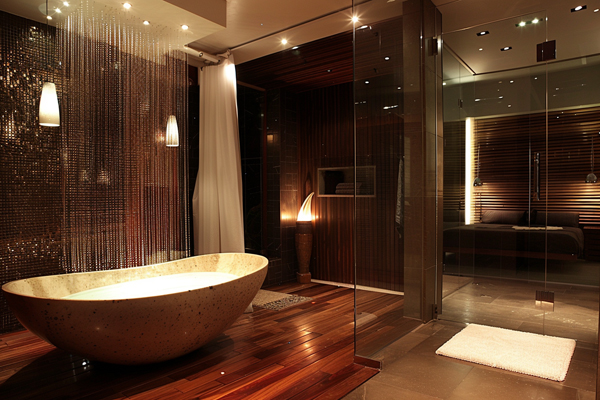
Can You Add a Shower to a Garden Tub?
Garden tubs are traditionally designed without a showerhead, but homeowners sometimes opt for modifications.
| Feature | Garden Tub (Standalone) | Garden Tub with Shower Attachment |
|---|---|---|
| Aesthetic Appeal | Clean, luxurious look | May appear less elegant |
| Ease of Use | Ideal for soaking only | Adds flexibility for quick showers |
| Plumbing Requirements | Standard tub installation | May require extra plumbing work |
| Water Containment | Open design, no curtain or enclosure | Needs splash protection (e.g., glass panels) |
How to Add a Shower to a Garden Tub
If you prefer the option of both soaking and showering, consider these solutions:
- Handheld Shower Head: A detachable shower head allows flexibility while preserving the tub’s open design.
- Overhead Shower with Glass Enclosure: Installing a wall-mounted shower with glass panels keeps the water contained.
- Freestanding Shower Conversion: A ceiling-mounted rain shower can create a spa-like experience without compromising elegance.
Is a Shower-Garden Tub Combo Right for You?
If you primarily enjoy deep soaking, a standalone garden tub is the best choice. However, if you need a functional shower option, installing an attachment or enclosure can enhance convenience while maintaining a stylish bathroom setup.
How many gallons of water does a typical garden tub hold?
Garden tubs require a significant amount of water.
A typical garden tub holds between 70-110 gallons of water7, depending on its size.
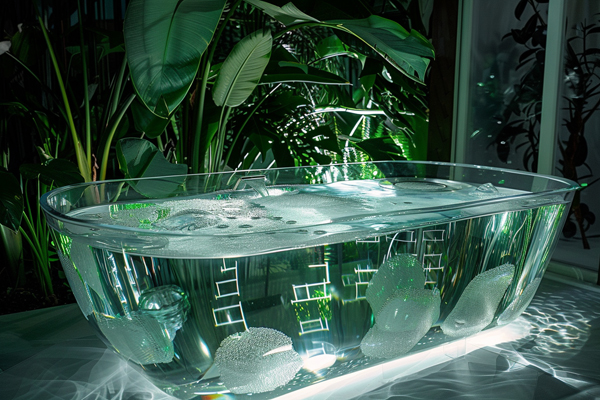
Understanding Garden Tub Water Capacity
The amount of water a garden tub holds depends on size, depth, and design.
| Tub Size | Approximate Water Capacity |
|---|---|
| Small (54 inches) | 70-80 gallons |
| Medium (60 inches) | 80-100 gallons |
| Large (72 inches or more) | 100-110+ gallons |
Factors That Affect Water Usage
- Depth: Deeper tubs naturally hold more water, making them ideal for full-body soaking.
- User Preference: Some people prefer partially filling the tub, reducing overall water consumption.
- Plumbing Setup: Homes with low water pressure or limited hot water capacity may struggle to fill large garden tubs efficiently.
Can Your Water Heater Handle a Garden Tub?
Before installing a garden tub, check your water heater size:
| Water Heater Capacity | Recommended Maximum Tub Size |
|---|---|
| 40 gallons | Small garden tub (54 inches) |
| 50 gallons | Medium garden tub (60 inches) |
| 80+ gallons | Large garden tub (72 inches or more) |
Is a Garden Tub Worth the Water Usage?
If you enjoy deep, immersive soaking, a garden tub is a great choice. However, it’s important to consider water efficiency and ensure your home’s plumbing can accommodate its high capacity.
Can two people comfortably fit in a garden tub?
Most garden tubs are spacious enough for two.
A standard garden tub is large enough for dual occupancy, but comfort depends on the specific dimensions.
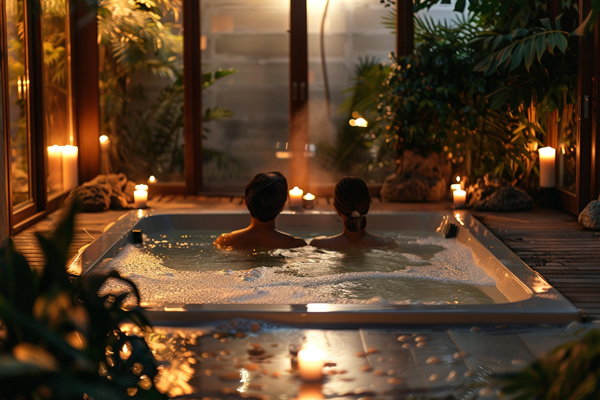
What Determines If a Garden Tub Fits Two People?
The ability for two people to comfortably fit in a garden tub depends on size, shape, and depth.
| Factor | Ideal for Two People? |
|---|---|
| Tub Length | At least 60-72 inches |
| Tub Width | 42 inches or more |
| Depth | 24 inches or deeper |
| Shape | Oval and round designs provide more space |
Best Garden Tub Sizes for Two
| Tub Size | Fits Two People? | Notes |
|---|---|---|
| 54 inches | No | Too compact for dual soaking |
| 60 inches | Maybe | Tight fit, but possible |
| 72 inches | Yes | Spacious and comfortable |
Things to Consider
- Body Positioning: Some tubs allow side-by-side seating, while others are designed for facing each other.
- Water Usage: A larger tub for two requires more water and may need a bigger water heater.
- Comfort Features: Sloped backrests and armrests enhance relaxation for both occupants.
Is a Two-Person Garden Tub Right for You?
If you enjoy shared soaking experiences, a 72-inch garden tub is the best option. For solo relaxation with extra space, a 60-inch tub may still be suitable. Be sure to measure your bathroom space before choosing the right size!
Are garden tubs outdated, or are they making a comeback?
Garden tubs were once considered outdated, but they are resurging in popularity.
Modern bathroom designs incorporate them as a luxurious, freestanding centerpiece.

Why Are Garden Tubs Becoming Popular Again?
While garden tubs fell out of favor in the early 2000s due to space constraints and the rise of walk-in showers, they are now making a strong comeback in modern bathroom designs.
| Trend Factor | Impact on Garden Tub Popularity |
|---|---|
| Freestanding Bathtub Trend | Homeowners seek statement tubs for a spa-like experience. |
| Luxury and Relaxation Focus | Deep soaking tubs are favored for self-care and stress relief. |
| Bigger Bathroom Spaces | New home designs include larger master baths, making room for garden tubs. |
| Customization Options | Modern garden tubs come in various materials, shapes, and features, fitting different aesthetics. |
Modern Garden Tub Features
Today’s garden tubs are more stylish and functional than ever:
- Sleek Freestanding Designs – No longer just a bulky oval tub, newer models feature minimalist curves and clean lines.
- Premium Materials – Options like stone resin, acrylic, and copper offer durability and elegance.
- Smart Features – Some models now include built-in LED lighting, air jets, and ergonomic contours for a better bathing experience.
Should You Consider a Garden Tub?
If you have the space and enjoy long, relaxing baths, a modern garden tub is a great investment. While they may not fit in every bathroom, they remain a timeless luxury feature for homeowners looking to enhance their personal retreat.
How much does it cost to install or replace a garden tub?
Costs vary based on the tub's material and installation requirements.
On average, installing a garden tub8 costs between $1,500 and $5,000, including plumbing adjustments.

Factors Affecting Installation Costs
The total cost of installing or replacing a garden tub depends on several key factors:
| Cost Factor | Price Range | Notes |
|---|---|---|
| Tub Material | $700 - $3,500 | Acrylic is more affordable; stone or copper is premium. |
| Plumbing Work | $500 - $2,000 | Includes adjusting pipes and water supply. |
| Labor Costs | $500 - $1,500 | Professional installation ensures correct setup. |
| Floor Reinforcement | $300 - $1,000 | Required for heavy tubs in upper-level bathrooms. |
| Additional Features | $200 - $1,500 | Jets, LED lighting, and custom finishes add costs. |
Cost Comparison: New Installation vs. Replacement
| Installation Type | Average Cost | Additional Considerations |
|---|---|---|
| New Installation | $2,500 - $5,000 | Includes full plumbing and structural setup. |
| Replacement | $1,500 - $3,500 | Cheaper if existing plumbing is compatible. |
Hidden Costs to Watch For
- Demolition & Removal: If replacing an old tub, expect an extra $200 - $500 for removal.
- Permits & Inspections: Some areas require permits, adding $100 - $300 to the cost.
- Tile & Waterproofing: If upgrading the surrounding area, budget for tile work and sealing.
Is a Garden Tub Worth the Investment?
If you have the space and budget, a garden tub adds luxury and home value. While it requires higher upfront costs, the spa-like experience and aesthetic appeal make it a worthwhile upgrade.
Is it possible to replace a garden tub with a walk-in shower?
Yes, many homeowners opt to replace garden tubs9 with showers.
A walk-in shower provides more practical use of space, especially in smaller bathrooms.
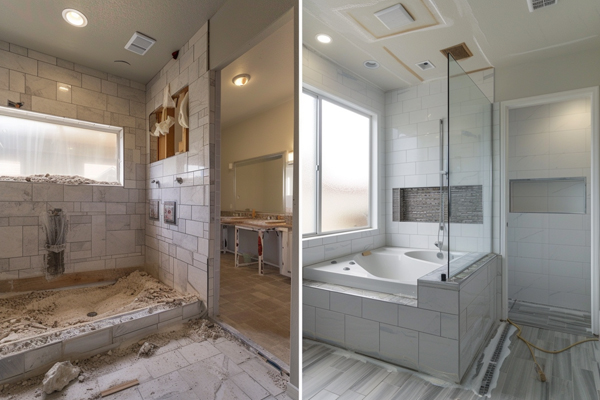
Key Benefits of Replacing a Garden Tub with a Walk-In Shower
Many homeowners choose to swap out their garden tub for a walk-in shower due to space efficiency and modern functionality.
| Benefit | Why It Matters |
|---|---|
| Space-Saving | A shower takes up less room, making the bathroom feel larger. |
| Easier Access | No high tub walls to step over, ideal for aging-in-place. |
| Water Efficiency | Uses less water per use compared to a large garden tub. |
| Modern Aesthetic | Sleek, contemporary designs enhance bathroom appeal. |
| Increased Home Value | Updated bathrooms attract buyers and boost resale value. |
Steps to Convert a Garden Tub to a Walk-In Shower
- Assess Plumbing Compatibility – Ensure the existing plumbing layout can accommodate a shower drain and fixtures.
- Remove the Garden Tub – A professional plumber or contractor will disconnect plumbing and remove the tub.
- Install the Shower Base or Pan – Choose from curbless, low-threshold, or standard shower pans.
- Add Waterproofing and Drainage – Proper sealing prevents leaks and ensures durability.
- Select Shower Features – Decide on glass enclosures, tile walls, built-in shelves, and rainfall showerheads.
Cost Considerations
| Conversion Expense | Estimated Cost Range |
|---|---|
| Tub Removal | $300 - $800 |
| Plumbing Adjustments | $500 - $2,000 |
| New Shower Installation | $2,000 - $7,000 |
| Custom Tile Work | $1,000 - $3,500 |
| Glass Enclosure | $800 - $3,000 |
Should You Make the Switch?
If you rarely use your garden tub, replacing it with a walk-in shower is a smart investment. It maximizes space, adds convenience, and modernizes your bathroom, making it a great upgrade for both personal use and resale value.
Conclusion
Garden tubs are luxurious, deep-soaking bathtubs that provide a spa-like experience in residential settings. They differ from standard, Roman, and hot tubs in size, design, and purpose. While they were once considered outdated, modern interior trends have revived their appeal. Though they require substantial space and water, they offer unmatched relaxation. When considering installation, it’s essential to factor in plumbing adjustments and costs. For homeowners looking to maximize bathroom space, replacing a garden tub with a walk-in shower is a common alternative.
-
Discover the advantages of garden tubs and how they can enhance your bathroom's luxury and comfort. ↩
-
Learn about the health and relaxation benefits of deep soaking bathtubs, perfect for enhancing your self-care routine. ↩
-
Learn about hydrotherapy and its benefits in hot tubs, enhancing your relaxation and wellness experience. ↩
-
Explore the unique features and benefits of Roman tubs, including their elegant design and installation options. ↩
-
Discover how garden tubs transform mobile home bathrooms into relaxing retreats. ↩
-
Learn about installing shower attachments on garden tubs to maximize functionality without sacrificing style. ↩
-
This resource will give you detailed insights into the water capacity of various garden tubs, helping you choose the right one. ↩
-
Find detailed cost breakdowns and factors influencing garden tub installation to budget effectively for your renovation. ↩
-
Learning the process of replacing garden tubs can guide you through a successful bathroom renovation. ↩










